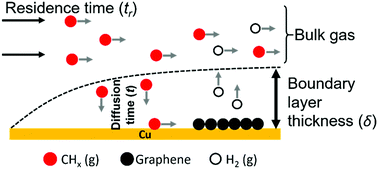The role of gas-phase dynamics in interfacial phenomena during few-layer graphene growth through atmospheric pressure chemical vapour deposition†
Abstract
The complicated chemical vapour deposition (CVD) is currently the most viable method of producing graphene. Most studies have extensively focused on chemical aspects either through experiments or computational studies. However, gas-phase dynamics in CVD reportedly plays an important role in improving graphene quality. Given that mass transport is the rate-limiting step for graphene deposition in atmospheric-pressure CVD (APCVD), the interfacial phenomena at the gas–solid interface (i.e., the boundary layer) are a crucial controlling factor. Accordingly, only by understanding and controlling the boundary-layer thickness can uniform full-coverage graphene deposition be achieved. In this study, a simplified computational fluid dynamics analysis of APCVD was performed to investigate gas-phase dynamics during deposition. Boundary-layer thickness was also estimated through the development of a customised homogeneous gas model. Interfacial phenomena, particularly the boundary layer and mass transport within it, were studied. The effects of Reynolds number on these factors were explored and compared with experimentally obtained results of the characterised graphene deposit. We then discussed and elucidated the important relation of fluid dynamics to graphene growth through APCVD.



 Please wait while we load your content...
Please wait while we load your content...